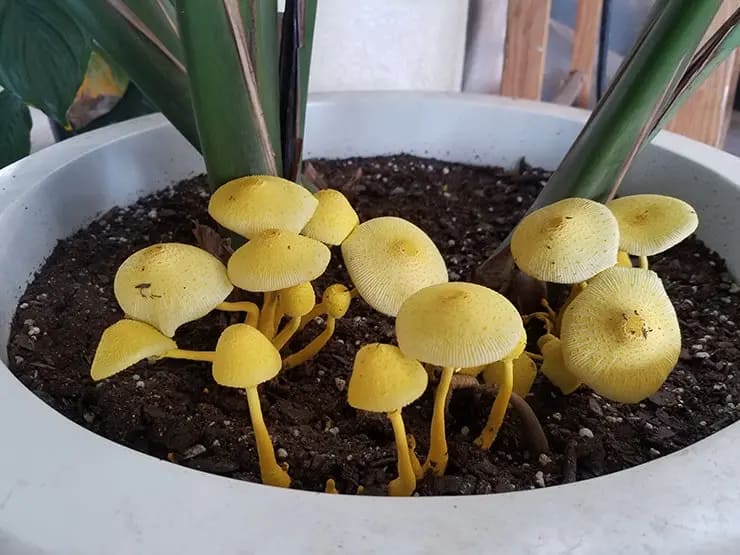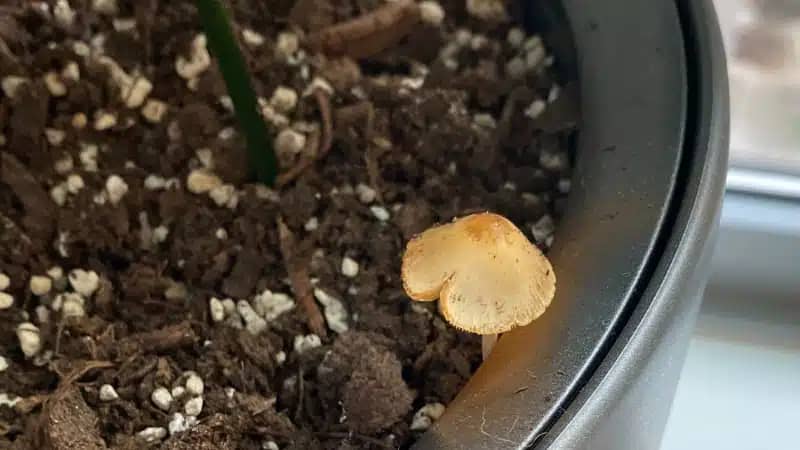Mushroom in Potted Plant
If you’ve ever noticed a small mushroom popping up in your potted plant, you’re not alone. It’s a common occurrence that often catches plant owners by surprise. While mushrooms are typically associated with the wild outdoors, they can occasionally make an appearance in your indoor houseplants, adding an unexpected twist to your gardening experience.
But why do mushrooms grow in potted plants? Is it harmful, and what should you do about it? Let’s explore these questions and provide you with actionable steps to keep your potted plants healthy and mushroom-free.
How Long Do Mushrooms Stay in Your System?
Why Do Mushrooms Grow in Potted Plants?
Mushrooms thrive in environments where moisture, organic matter, and the right conditions for fungi are present. Potted plants offer an ideal environment for mushrooms, especially if the soil is rich in organic material. The fungi responsible for mushroom growth break down this organic matter, making it easier for your plant to absorb nutrients. So, in some ways, the presence of mushrooms indicates that your soil is nutrient-rich.
However, mushrooms in houseplants can be concerning for a few reasons. While they aren’t typically harmful to your plant, they can be a sign of overly damp soil, which could lead to root rot or other issues down the line. Additionally, some people prefer to avoid mushrooms in their indoor plants due to the potential presence of toxic varieties, especially if pets or small children are around.
The Life Cycle of Mushroom in Potted Plant
Understanding the life cycle of mushrooms can help you manage their appearance in your potted plants. Mushrooms begin as tiny spores that are often present in the air or in the soil mix you purchase. When these spores land in a suitable environment – like the moist, nutrient-rich soil of your potted plant – they begin to grow and form mycelium, a network of thread-like structures that eventually produce mushrooms.

Yellow Mushrooms in Potted Plants What They Are and How to Get Rid of Them
These mushrooms will sprout when the conditions are just right, typically after watering or during periods of high humidity. They can appear suddenly and disappear just as quickly, but the mycelium can persist in the soil, leading to future mushroom growth if not properly addressed.
Are Mushrooms Harmful to Your Potted Plants?
Mushrooms themselves aren’t directly harmful to your potted plants. In fact, they can be beneficial by helping to break down organic matter in the soil, which in turn nourishes your plant. However, their presence can be a sign that your plant’s environment is too damp, which is not ideal for most houseplants.
Excess moisture can lead to problems such as root rot, mold growth, and the proliferation of other unwanted fungi. Moreover, some varieties of mushrooms can be toxic if ingested, posing a risk to pets or children who might come into contact with them.
Preventing Mushroom Growth in Potted Plants
If you want to prevent mushrooms from appearing in your potted plants, there are several steps you can take to modify the growing environment and reduce the likelihood of fungal growth.
- Monitor Watering Practices: One of the most effective ways to prevent mushrooms is by adjusting your watering habits. Potted plants should be watered only when the top inch of soil feels dry to the touch. Overwatering not only encourages mushroom growth but can also harm your plant by promoting root rot.
- Improve Drainage: Ensure that your pots have proper drainage holes to allow excess water to escape. You can also add a layer of gravel or small stones at the bottom of the pot to enhance drainage and prevent water from sitting at the base, creating an ideal environment for mushrooms.
- Use Sterilized Potting Soil: When repotting your houseplants or planting new ones, use sterilized potting soil to minimize the presence of fungal spores. This can reduce the chances of mushrooms appearing in your plants.
- Reduce Humidity: If you live in a humid environment, consider using a dehumidifier or increasing airflow around your plants. You can also place your potted plants in less humid areas of your home.
- Remove Organic Debris: Regularly remove dead leaves, flowers, and other organic debris from the soil surface. This material can decompose and provide food for fungi, encouraging mushroom growth.
How to Safely Remove Mushroom in Potted Plant
If you already have mushrooms growing in your potted plants, don’t worry – they can be removed with relative ease. However, it’s important to do so carefully to avoid spreading the spores or damaging your plant.
- Gently Remove the Mushrooms: Wear gloves and carefully pick the mushrooms from the soil surface. Be sure to remove the entire mushroom, including the base, to prevent regrowth.
- Dispose of Mushrooms Properly: Place the removed mushrooms in a sealed bag and dispose of them in the trash. Avoid composting them, as this could spread the spores and lead to more mushrooms.
- Amend the Soil: After removing the mushrooms, consider lightly disturbing the soil to break up any remaining mycelium. This can help prevent future mushroom growth.
- Adjust Plant Care Practices: Review your plant care routine, especially your watering and humidity management, to create a less hospitable environment for fungi.
When to Be Concerned About Mushroom in Potted Plant
While most mushrooms are harmless to potted plants, there are a few scenarios where you might need to take additional precautions.
- Toxic Varieties: Some mushrooms are toxic to humans and animals. If you’re unsure about the type of mushroom growing in your plant, it’s best to remove it immediately and take steps to prevent further growth.
- Persistent Mushroom Growth: If mushrooms continue to appear despite your efforts to remove them and adjust care practices, it might indicate a more significant issue with the soil or environment. Consider repotting your plant with fresh, sterilized soil and a clean pot.
- Impact on Plant Health: If your plant starts to show signs of distress, such as yellowing leaves or stunted growth, and mushrooms are present, it could indicate an underlying issue with moisture levels or soil health. Address these issues promptly to protect your plant.
How to Remove Yellow Mushrooms from Potted Plants
Fungi in Houseplants: The Bigger Picture
Mushrooms aren’t the only fungi that might appear in your houseplants. You might also encounter mold or mildew, particularly in humid conditions. Like mushrooms, these fungi thrive in damp environments and can indicate that your plant’s care routine needs adjustment.
- Mold on Soil: White or gray mold on the surface of your plant’s soil is often a sign of overwatering or poor air circulation. Removing the mold and adjusting your watering practices can help.
- Mildew on Leaves: Mildew appears as a powdery white substance on the leaves and is usually caused by high humidity or poor airflow. Increasing ventilation and reducing humidity can prevent mildew.
Embracing the Natural Process of Fungi in Plants
While it can be unsettling to find mushrooms in your potted plant, it’s important to remember that fungi play a crucial role in the natural ecosystem. They break down organic matter, help recycle nutrients, and support the overall health of the soil. In some cases, their presence can be a sign that your plant’s soil is healthy and full of beneficial organisms.
However, maintaining a balance is key. By managing moisture levels, ensuring good drainage, and keeping an eye on your plant’s overall health, you can enjoy the benefits of nutrient-rich soil without the unwanted appearance of mushrooms.
Common Myths About Mushrooms in Potted Plants
There are several myths and misconceptions surrounding mushrooms in potted plants. Let’s clear up some of the most common ones:
- Myth: Mushrooms Mean the Plant is Sick: Not necessarily. While persistent mushroom growth can indicate a moisture issue, a single mushroom doesn’t mean your plant is unhealthy. It’s often a sign of a nutrient-rich environment.
- Myth: All Mushrooms Are Dangerous: While some mushrooms are toxic, many are harmless. However, it’s still wise to remove any mushrooms from your houseplants to avoid potential risks.
- Myth: You Should Always Repot Your Plant If Mushrooms Appear: Repotting isn’t always necessary. In many cases, simply adjusting your watering and removing the mushrooms can resolve the issue.
FAQs
What causes mushrooms to grow in potted plants?
Mushrooms grow in potted plants due to the presence of fungal spores in the soil, combined with moisture and organic matter. These conditions create an ideal environment for fungi to thrive.
Are mushrooms in potted plants harmful to humans or pets?
Some mushrooms can be toxic if ingested. It’s important to remove mushrooms from your houseplants to prevent any accidental ingestion by pets or children.
Can mushrooms damage my potted plant?
Mushrooms themselves don’t typically harm the plant, but their presence can indicate excessive moisture, which could lead to other issues like root rot.
How can I prevent mushrooms from growing in my potted plants?
To prevent mushrooms, monitor your watering habits, improve soil drainage, use sterilized potting soil, and reduce humidity around your potted plants.
Should I repot my plant if I find mushrooms in the soil?
Repotting isn’t always necessary. Often, adjusting watering practices and removing the mushrooms is enough to manage the issue.
Can I use fungicides to get rid of mushrooms in potted plants?
Fungicides are generally not recommended for treating mushrooms in houseplants. Addressing the underlying moisture issue is a more effective solution.
Finding a mushroom in your potted plant can be surprising, but it’s a common occurrence that many plant owners face. By understanding why mushrooms grow in houseplants and taking steps to manage the environment, you can keep your plants healthy and free from unwanted fungi. Remember, a little extra care in your watering routine and soil management can go a long way in preventing mushrooms from sprouting in your beloved potted plants.

